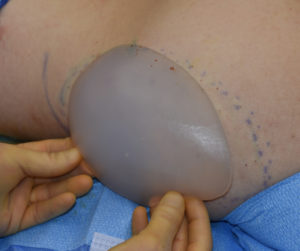The use of implants for body augmentation has been around for over fifty years. Breast implants are the most well known and account for the majority of all body contouring implants placed. But there are a variety of other body site implants that are recognized by most even if they occupy a small number of all body implantations performed. Implants exist for the chest, buttocks, arms and calfs. The numbers of these implant sites is increasing along with the array of implant options that are available for them.
One would think that just about every body site that could be augmented or implanted has been…but this is not true. One new area for body augmentation is that of the hips or thighs. Depending upon how you define this location, the goal is to have more curvature to the upper outer thigh. This seems ironic since most plastic surgery efforts are spent trying to reduce fullness in this area by liposuction. But there are women (and transgender females) that want a more curvaceous look to their outer thighs which is naturally very straight.

Other than some tightness of the outer thighs and the potential for infection or seroma (fluid collection), the risk of complications is fairly lower. The anatomy in this area has no major blood vessels or nerves. The muscle is not entered or violated so this hastens recovery. The only nerve of consequence is the lateral femoral cutaous nerve which supplies feeling to the lateral thigh, but its course is above and in from of the location of the incision. Recovery is fairly short in terms of returning to normal activities but strenuous activity and exercise requires waiting a full month after surgery.
The hip or upper thigh implant provides a curve or fullness to the upper outer thigh. These relatively thin slightly convex silicone implants are placed subfascially on top of the muscle to augment an otherwise straight leg line. For those women who have little fat to give for fat injection hip augmentation, an actual preformed implant is an alternative body contouring option.
Dr. Barry Eppley
Indianapolis, Indiana


